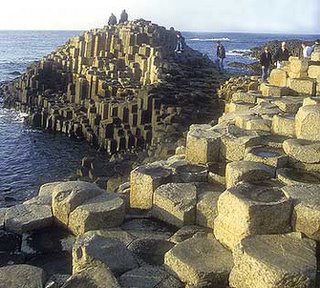The Giants Causeway

The Giants Causeway, found in County Anterim at the very North of Ireland, is one of the most striking wonders of the natural world. There are nearly 40,000 of these mostly hexagonal stone columns that begin at the foot of a cliff and continue into the sea. These basalt stones were formed through the quick crystallization of lava from volcanic eruptions. However, as legend would have it, a famed Irish giant named Fionn Mac Cumhail is said to have built the causeway as stepping stones so that his lover could get to him from Scotland to Anterim without getting her feet wet. Hence the name “The Giants Causeway.”
PART II
The Man and His Boots
By: William Butler Yeats
There was a doubter in Donegal, and he would not hear of ghosts or faeries, and there was a long house in Donegal that had been haunted as long as man could remember, and this is the story of how the house got the better of the man. The man came into the house and lightened a fire in the room under the haunted one, and took off his boots and set them on the hearth, and stretched out his feet and warmed himself. For a time he prospered in his unbelief; but a little while after the night had fallen, and everything had gotten very dark, one of his boots began to move. It got up off the floor and gave a kind of slow jump towards the door, and then the other boot did the same, and after that the first boot jumped again. And thereupon it occurred to the man that an invisible being had got into his boots, and was now going away in them. When the boots reached the door they went upstairs slowly, and then the man heard them go tramp, tramp round the haunted room over his head. A few minutes passed, and he could hear them again upon the stairs, and after that in the passage outside, and then one of them came in at the door, and the other gave a jump past it and came in too. They jumped along towards him, and then one got up and hit him, and afterwards the other hit him, and then again the first hit him, and so on, until they drove him out of the room, and finally out of the house. In this way he was kicked out by his own boots, and Donegal was avenged upon its doubter. It is not recorded whether the being was a ghost or one of the Sidhe, but the fantastic nature of the vengeance is like the work of the Sidhe who live in the heart of fantasy.
This excerpt came from a book I found at a used book store a while ago called “Mythologies,” which is a compilation done by Yeats’ wife of his works regarding mythology or fantasy. It’s split into 5 different sections or categories, this excerpt was from the first section called “The Celtic Twilight.” It’s a great book if you have the time to read it.
I chose this excerpt because I thought it was funny. When I was reading the book it was one of my favorites. It’s short, simple, ironic, and descriptive. I really enjoy Yeats’ writing because it’s easy for me to follow. The folklore and fantasy side of Ireland has always interested me and I felt that this example was great because it treats the myth as a moral.
Part III
I wanted to take this class for several reasons. I’ve got some Irish blood (not a whole lot, but some). I, of course, am a fan of William Butler Yeats and his beautiful writing. Irish traditional music occupies a gig or two on my iPod. I’ve attended two of Dr. Smith’s slow sessions in the past, but due to my crazy schedule was unable to go to more. It was VERY interesting and I learned a LOT. It is definitely something I want to know more about and how to do. The performance practice is what is most fascinating to me. I also did a brief amount of research on Ireland's medieval music history for a research paper last semester. It was very interesting reading about bards and the like. I have a friend in Cork as well. Unfortunately for him, he gets a lot of really annoying questions from me on a very frequent basis. It works out well for me, though, because he sends me BEAUTIFUL online pictures of places that I can’t even imagine seeing in person.

2 Comments:
Great story! Yeats was important not only as a poet and playwright, but also as a folklore collector, with his mentor Lady Gregory. And much of his original poetry shows the strong influence of traditional songs and stories.
There are a number of stories about the Giant's Causeway. Another version to the one you've told is that a giant was coming from Scotland to do battle with the Irish hero Finn MacCoul. Finn, knowing he couldn't defeat the giant, disguised himself in infant's clothing and cried aloud like a baby. The giant looked at this 8-foot-tall baby and said "if the Irish infants are so big, how huge must the full-grown men be?!?" and fled back to Scotland.
I do indeed have favorites. The reel "Drowsie Maggie" was actually one of the first trad tunes I actually remember seriously listening to. The recording I have is in a set including "Black-Haired Lass" and "Morning Dew" off of a CD I burned from my dad before my freshman year. I came across a song called "Oro Mo Bhadin" in a book for one of the classes I was taking and it is also among my favorites. I also think "The Rocky Road to Dublin" is a fun one. I have a (sad) midi version of it heralding my website.
Post a Comment
<< Home